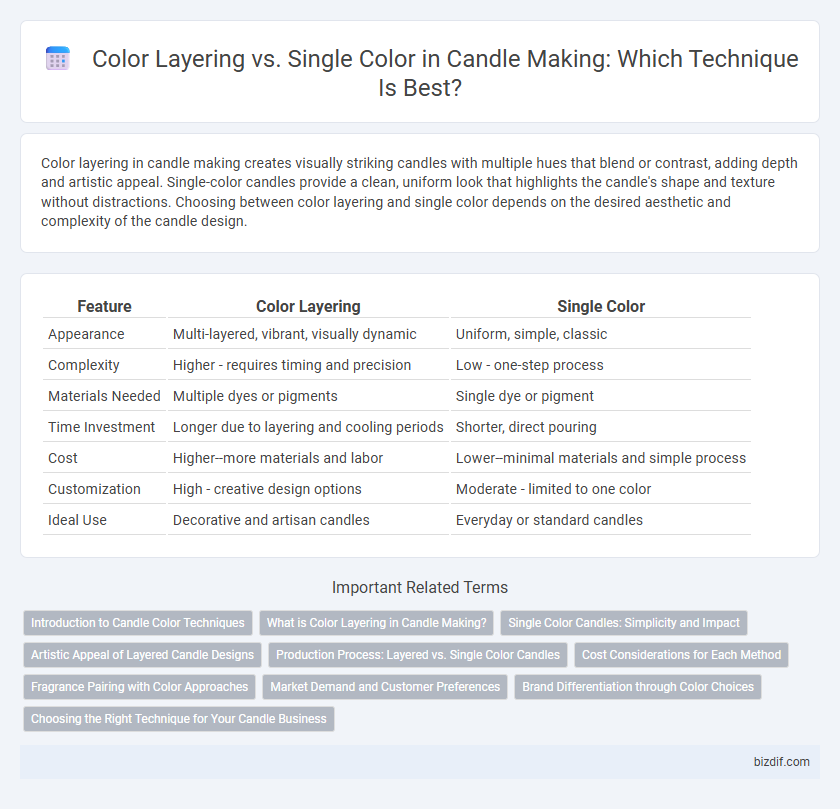Color layering in candle making creates visually striking candles with multiple hues that blend or contrast, adding depth and artistic appeal. Single-color candles provide a clean, uniform look that highlights the candle's shape and texture without distractions. Choosing between color layering and single color depends on the desired aesthetic and complexity of the candle design.
Table of Comparison
| Feature | Color Layering | Single Color |
|---|---|---|
| Appearance | Multi-layered, vibrant, visually dynamic | Uniform, simple, classic |
| Complexity | Higher - requires timing and precision | Low - one-step process |
| Materials Needed | Multiple dyes or pigments | Single dye or pigment |
| Time Investment | Longer due to layering and cooling periods | Shorter, direct pouring |
| Cost | Higher--more materials and labor | Lower--minimal materials and simple process |
| Customization | High - creative design options | Moderate - limited to one color |
| Ideal Use | Decorative and artisan candles | Everyday or standard candles |
Introduction to Candle Color Techniques
Color layering in candle making creates visually dynamic designs by pouring multiple wax colors sequentially, allowing each layer to solidify before adding the next. Single color candles emphasize uniformity and simplicity, using a consistent pigment throughout the wax blend for a smooth, monochromatic finish. Both techniques rely on pigment compatibility and temperature control to achieve vibrant, long-lasting colors in candle production.
What is Color Layering in Candle Making?
Color layering in candle making involves pouring multiple layers of differently colored wax sequentially to create a visually appealing, striped effect. Unlike single-color candles that use one uniform shade, color layering allows for intricate designs and depth by controlling the temperature and pouring timing of each wax layer. This technique enhances the candle's aesthetic value and can emphasize themes or moods through contrasting or complementary colors.
Single Color Candles: Simplicity and Impact
Single color candles offer a clean, minimalist aesthetic that emphasizes simplicity and elegance in candle making. Their uniform hue enhances the visual impact, creating a strong focal point in any space while showcasing the natural texture and shape of the candle. This approach reduces complexity in the crafting process, making single color candles ideal for both beginners and artisans seeking a timeless, sophisticated result.
Artistic Appeal of Layered Candle Designs
Layered candle designs offer a striking visual depth and complexity that single-color candles lack, enhancing the artistic appeal through contrasting or complementary hues. The interplay of colors in layered candles creates dynamic patterns and textures, elevating the candle from a simple object to a decorative piece. This multi-dimensional approach allows artisans to experiment with color combinations, resulting in unique and captivating creations that engage the viewer's eye.
Production Process: Layered vs. Single Color Candles
Layered candles require a meticulous production process involving multiple pours and cooling phases to achieve distinct color bands. Single color candles streamline manufacturing by using a uniform wax mixture, reducing time and complexity. The choice between color layering and single color affects production efficiency, material handling, and final aesthetic appeal.
Cost Considerations for Each Method
Color layering in candle making often requires multiple dyes or pigments and separate pouring sessions, increasing both material and labor costs compared to using a single color. Single-color candles streamline production by minimizing ingredient variety and reducing time, resulting in lower overall expenses. Budget-conscious makers should weigh the higher cost of color layering against the visual appeal and potential price premium it can command.
Fragrance Pairing with Color Approaches
Color layering in candle making enhances fragrance complexity by allowing distinct scents to emerge with each color layer, creating a dynamic olfactory experience. Single color candles offer a uniform scent profile, matching one fragrance closely to a specific color, which simplifies fragrance pairing but limits depth. Strategic pairing of complementary fragrances with layered colors maximizes sensory appeal, while single-colored candles benefit from choosing strong, singular scents to maintain consistency.
Market Demand and Customer Preferences
Color layering in candle making caters to a growing market demand for visually appealing and customizable products, attracting customers seeking unique decor and personalized gifts. Single-color candles remain popular for their simplicity, elegance, and ability to complement minimalist or classic home aesthetics. Consumer preferences increasingly favor layered colors for special occasions, while single tones maintain steady demand in everyday and bulk purchases.
Brand Differentiation through Color Choices
Color layering in candle making creates visually striking, multi-dimensional designs that enhance brand differentiation by offering unique aesthetic experiences compared to single color candles. Brands leveraging intricate color combinations can attract niche markets seeking artisanal craftsmanship and personalized decor, reinforcing their identity and value proposition. Single color candles remain popular for minimalist appeal and consistency but may face challenges standing out in saturated markets without distinctive packaging or scent integration.
Choosing the Right Technique for Your Candle Business
Color layering in candle making allows artisans to create visually striking designs by pouring multiple colored wax layers, appealing to customers seeking unique aesthetics. Single color candles offer simplicity and consistency, which can streamline production and attract buyers prioritizing minimalism and uniformity. Evaluating your target market's preferences and production capabilities will help determine whether color layering or single color techniques best enhance your candle business's profitability and branding.
Color layering vs Single color Infographic

 bizdif.com
bizdif.com